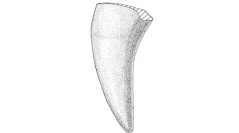

 Geodiversitas
22 (3) - Pages 325-348
Geodiversitas
22 (3) - Pages 325-348In the eastern part of the Aix-en-Provence basin (SE France), a thick clay and sandstone alternance represents the Begudian to Rognacian transition (part of the continental Late Cretaceous of the Provence area). These levels include the La Neuve fossil site. Only briefly cited until now, this locality is the matter for a first general account. Its geological, stratigraphic and sedimentological aspects are stated. The fossil assemblage includes plants as well as terrestrial and freshwater animals. Among them, charophytes, gastropods, ostracods, amphibians and reptiles are significantly documented. Original data are obtained for ostracods with a new generic type, amphibians, and eggshell material with four structural types represented. On the charophyte evidence, the age of the locality is Begudian, and the concerned biozone directly correlates to the Chron 33N (middle and late Campanian). Aspects of taphonomical genesis, relative diversity, paleoenvironment and paleogeography are discussed.
Late Cretaceous, continental, SE France, charophytes, invertebrates, vertebrates, eggshells